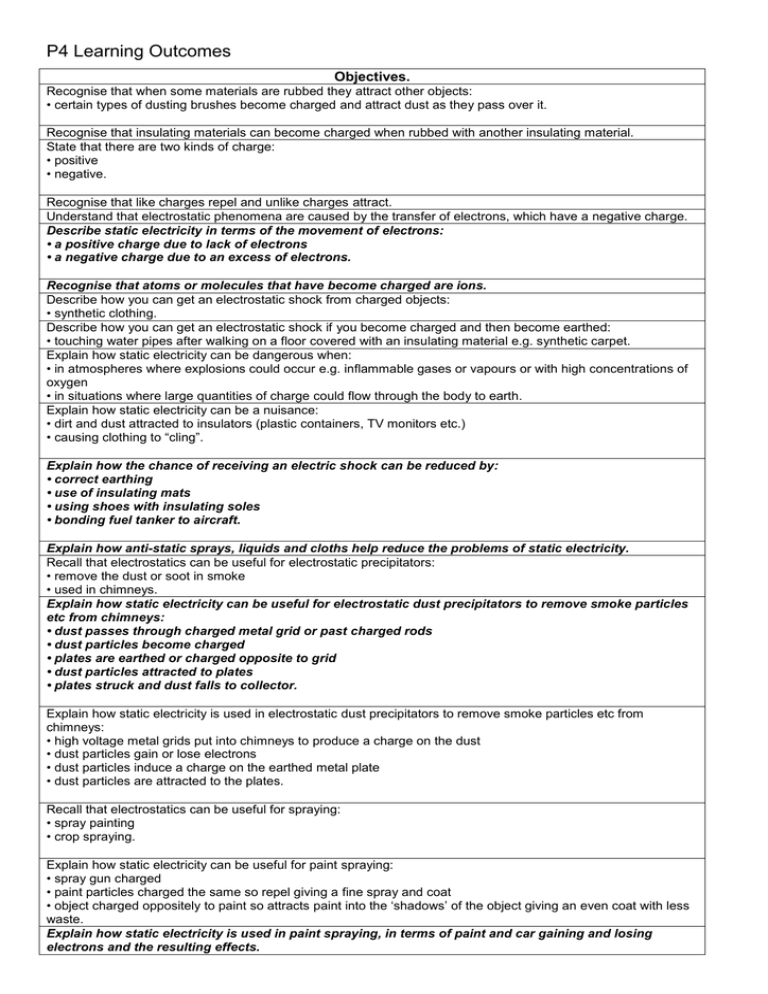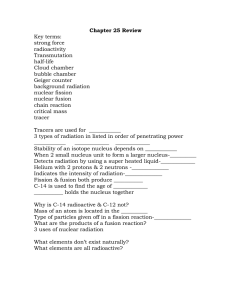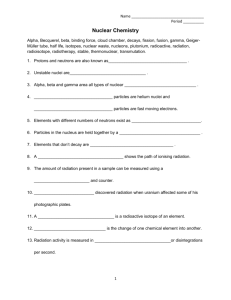P4_Learning_outcomes
advertisement

P4 Learning Outcomes Objectives. Recognise that when some materials are rubbed they attract other objects: • certain types of dusting brushes become charged and attract dust as they pass over it. Recognise that insulating materials can become charged when rubbed with another insulating material. State that there are two kinds of charge: • positive • negative. Recognise that like charges repel and unlike charges attract. Understand that electrostatic phenomena are caused by the transfer of electrons, which have a negative charge. Describe static electricity in terms of the movement of electrons: • a positive charge due to lack of electrons • a negative charge due to an excess of electrons. Recognise that atoms or molecules that have become charged are ions. Describe how you can get an electrostatic shock from charged objects: • synthetic clothing. Describe how you can get an electrostatic shock if you become charged and then become earthed: • touching water pipes after walking on a floor covered with an insulating material e.g. synthetic carpet. Explain how static electricity can be dangerous when: • in atmospheres where explosions could occur e.g. inflammable gases or vapours or with high concentrations of oxygen • in situations where large quantities of charge could flow through the body to earth. Explain how static electricity can be a nuisance: • dirt and dust attracted to insulators (plastic containers, TV monitors etc.) • causing clothing to “cling”. Explain how the chance of receiving an electric shock can be reduced by: • correct earthing • use of insulating mats • using shoes with insulating soles • bonding fuel tanker to aircraft. Explain how anti-static sprays, liquids and cloths help reduce the problems of static electricity. Recall that electrostatics can be useful for electrostatic precipitators: • remove the dust or soot in smoke • used in chimneys. Explain how static electricity can be useful for electrostatic dust precipitators to remove smoke particles etc from chimneys: • dust passes through charged metal grid or past charged rods • dust particles become charged • plates are earthed or charged opposite to grid • dust particles attracted to plates • plates struck and dust falls to collector. Explain how static electricity is used in electrostatic dust precipitators to remove smoke particles etc from chimneys: • high voltage metal grids put into chimneys to produce a charge on the dust • dust particles gain or lose electrons • dust particles induce a charge on the earthed metal plate • dust particles are attracted to the plates. Recall that electrostatics can be useful for spraying: • spray painting • crop spraying. Explain how static electricity can be useful for paint spraying: • spray gun charged • paint particles charged the same so repel giving a fine spray and coat • object charged oppositely to paint so attracts paint into the ‘shadows’ of the object giving an even coat with less waste. Explain how static electricity is used in paint spraying, in terms of paint and car gaining and losing electrons and the resulting effects. P4 Learning Outcomes Recall that electrostatics can be useful for restarting the heart when it has stopped (defibrillator). Recall that defibrillators work by discharging charge. Explain how static electricity can be useful for restarting the heart when it has stopped (defibrillator): • paddles charged • good electrical contact with patient’s chest • charge passed through patient to make heart contract • care taken not to shock operator. Explain the behaviour of simple circuits in terms of the flow of electric charge. Describe and recognise how resistors can be used to change the current in a circuit. Describe how variable resistors can be used to change the current in a circuit: • longer wires give less current • thinner wires give less current (rheostat configured as a variable resistor only). Recall that resistance is measured in ohms. Explain how variable resistors can be used to change the current in a circuit: • longer wires have more resistance • thinner wires have more resistance (rheostat configured as a variable resistor only). Describe the relationships between current, voltage (pd) and resistance: • for a given resistor, current increases as voltage increases and vice versa • for a fixed voltage, current decreases as resistance increases and vice versa. Use the equation: resistance = voltage ––––––– current Use and apply the equation, including a change of subject: resistance = voltage ––––––– current Recall the colour coding for live, neutral and earth wires: • live – brown • neutral – blue • earth – green/yellow. State that an earthed conductor cannot become live. Describe the functions of the live, neutral and earth wires: • live – carries the high voltage • neutral – completes the circuit • earth – a safety wire to stop the appliance becoming live. Describe reasons for the use of fuses and circuit breakers (as re-settable fuses). Recognise that “double insulated” appliances do not need earthing. Explain how a wire fuse reduces the risk of fire; if the appliance develops a fault: • too large a current causes the fuse to melt • preventing flow of current • prevents flex overheating and causing fire • prevents further damage to appliance. Use the equation: power = voltage × current Explain why “double insulated” appliances do not need earthing: • the appliance is a non conductor and cannot become live. Explain the reasons for the use of fuses and circuit breakers as re-settable fuses (structure and mode of operation not required). Explain how the combination of a wire fuse and earthing protects people. Use the equation, including a change of subject: power = voltage × current to select a suitable fuse for an appliance. P4 Learning Outcomes Recall that ultrasound is a longitudinal wave. Recognise features of a longitudinal wave: • wavelength • compression • rarefaction. Describe features of longitudinal waves: • wavelength • frequency • compression (a region of higher pressure) • rarefaction (a region of lower pressure). Recall that the frequency of ultrasound is higher than the upper threshold of human hearing (20 000 Hz) because the ear cannot detect these very high frequencies. Describe and compare the motion and arrangement of particles in longitudinal and transverse physical waves: • wavelength • frequency • compression • rarefaction • amplitude. Recognise that ultrasound can be used in medicine for diagnostic purposes: • to look inside people by scanning the body • to measure the speed of blood flow in the body (candidates are not expected to describe the Doppler effect). Recognise that ultrasound can be used in medicine for non-invasive therapeutic purposes such as to break down kidney and other stones. Explain how ultrasound is used in: • body scans (reflections from different layers returning at different times from different depths) • breaking down accumulations in the body such as kidney stones. Explain the reasons for using ultrasound rather than X-rays for certain scans: • able to produce images of soft tissue • does not damage living cells. Recognise that the radioactivity or activity of an object is measured by the number of nuclear decays emitted per second. Understand that radioactivity decreases with time. Recall that nuclear radiation ionises materials. Describe radioactive substances as decaying naturally and giving out nuclear radiation in the form of alpha, beta and gamma. Explain and use the concept of half-life. Interpret graphical data of radioactive decay to include a qualitative description of half-life. Explain ionisation in terms of: • removal of electrons from particles • gain of electrons by particles. Interpret graphical or numerical data of radioactive decay to include calculation of half-life. Explain why alpha particles are such good ionisers. Recall that radiation comes from the nucleus of the atom. Describe radioactivity as coming from the nucleus of an atom that is unstable. Recall that an alpha particle is a helium nucleus. Recall that a beta particle is a fast moving electron. Describe what happens to a nucleus when an alpha particle is emitted: • mass number decreases by 4 • nucleus has two fewer neutrons • nucleus has two fewer protons • atomic number decreases by 2 • new element formed. Describe what happens to a nucleus when a beta particle is emitted: P4 Learning Outcomes • mass number is unchanged • nucleus has one less neutron • nucleus has one more proton • atomic number increases by one • new element formed. Construct and balance nuclear equations in terms of mass numbers and atomic numbers to represent alpha and beta decay. Understand why background radiation can vary. Recall that background radiation mainly comes from rocks and cosmic rays. Recall that some background radiation comes from waste products and man-made sources e.g. waste from: • industry • hospitals. Evaluate the relative significance of sources of background radiation. Recall industrial examples of the use of tracers: • to track dispersal of waste • to find leaks/blockages in underground pipes • to find the route of underground pipes. Describe how tracers are used in industry: • radioactive material put into pipe • progress tracked with detector above ground/outside pipe • leak/blockage shown by reduction/no radioactivity after the point of blockage. Explain why gamma radiation is used as an industrial tracer. Recall that alpha sources are used in some smoke detectors. Explain how a smoke detector with an alpha source works: • smoke particles hit by alpha radiation • less ionisation of air particles • current is reduced causing alarm to sound. Recall that radioactivity can be used to date rocks. Explain how the radioactive dating of rocks depends on the calculation of the uranium/lead ratio. Recall that measurements from radioactive carbon can be used to find the date of old materials. Explain how measurements of the activity of radioactive carbon can lead to an approximate age for different materials: • the amount of Carbon-14 in the air has not changed for thousands of years • when an object dies (e.g. wood) gaseous exchange with the air stops • as the Carbon-14 in the wood decays the activity of the sample decreases • the ratio of current activity from living matter to the activity of the sample is used to calculate the age within known limits. Describe some similarities and differences between X-rays and gamma rays: • both are ionising electromagnetic waves • have similar wavelengths • are produced in different ways. Recall that materials absorb some ionising radiation. Understand how the image produced by the absorption of X-rays depends on the thickness and density of the absorbing materials. Explain how: • gamma rays are given out: from the nucleus of certain radioactive materials • X-rays are made: by firing high speed electrons at metal targets • X-rays are easier to control than gamma rays. Recall that medical radioisotopes are produced by placing materials into a nuclear reactor. Describe how materials can become radioactive as a result of absorbing extra neutrons. Describe uses of nuclear radiation in medicine, to include: • diagnosis • treatment of cancer using gamma rays • sterilisation of equipment. Recall that only beta and gamma radiation can pass through skin. Recall that nuclear radiation can damage cells. P4 Learning Outcomes Describe the role of a radiographer and the safety precautions they must take. Explain why gamma (and sometimes beta) emitters can be used as tracers in the body. Understand why medical tracers should not remain active in the body for long periods. Explain how radioactive sources are used in medicine: 1. to treat cancer: • gamma rays focused on tumour • wide beam used • rotated round the patient with tumour at centre • limiting damage to non-cancerous tissue. 2. as a tracer: • beta or gamma emitter with a short half life • drunk/eaten/ingested/injected into the body • allowed to spread through the body • followed on the outside by a radiation detector. Recognise that nuclear power stations use uranium as a fuel. Describe the main stages in the production of electricity: • source of energy • used to produce steam • used to produce electricity. Describe how domestic electricity is generated at a nuclear power station: • nuclear reaction • producing heat • heating water to produce steam • spinning a turbine • driving a generator. Describe what happens to allow uranium to release energy: • uranium nucleus hit by neutron • causes nucleus to split • energy released • more neutrons released. Describe the process that gives out energy in a nuclear reactor as nuclear fission, and that it is kept under control. Recall that nuclear fission produces radioactive waste. Understand how the decay of uranium starts a chain reaction. Describe a nuclear bomb as a chain reaction that has gone out of control. Explain what is meant by a chain reaction: • when each uranium nucleus splits more than one neutron is given out • these neutrons can cause further uranium nuclei to split. Explain how scientists stop nuclear reactions going out of control: • rods placed in the reactor • to absorb some of the neutrons • allowing enough neutrons to remain to keep the process operating. Describe the difference between fission and fusion: • fission is the splitting of nuclei • fusion is the joining of nuclei. Describe how nuclear fusion releases energy: • fusion happens when two nuclei join together • fusion produces large amounts of heat energy • fusion happens at extremely high temperatures. Describe why fusion for power generation is difficult: • requires extremely high temperatures • high temperatures have to be safely managed. Understand why fusion power research is carried out as an international joint venture. Explain how different isotopes of hydrogen can undergo fusion to form helium. Understand the conditions needed for fusion to take place, to include: • in stars, fusion happens under extremely high temperatures and pressures • fusion bombs are started with a fission reaction which creates exceptionally high temperatures • for power generation exceptionally high temperatures and/or pressures are required and this combination offers (to date) safety and practical challenges. Recall that one group of scientists have claimed to successfully achieve ‘cold fusion’. Explain why the claims are disputed: other scientists could not repeat their findings. Explain why the ‘cold fusion’ experiments and data have been shared between scientists. Explain why ‘cold fusion’ is still not accepted as a realistic method of energy production.



